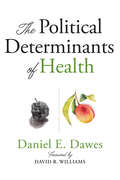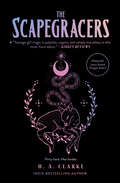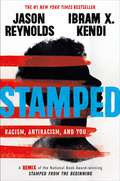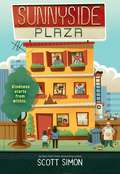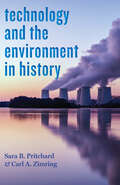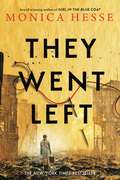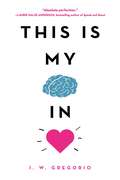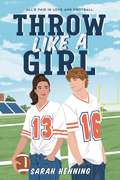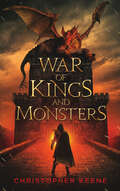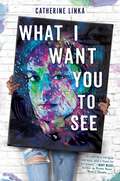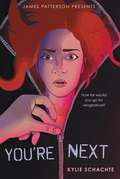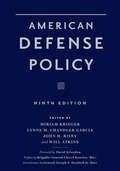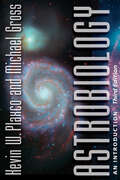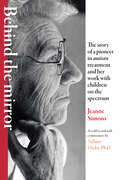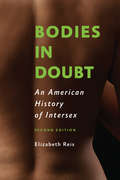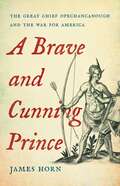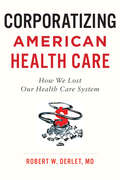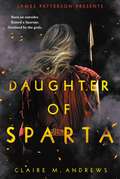- Table View
- List View
The Political Determinants of Health
by Daniel E. DawesReduced life expectancy, worsening health outcomes, health inequity, and declining health care options—these are now realities for most Americans. However, in a country of more than 325 million people, addressing everyone's issues is challenging. How can we effect beneficial change for everyone so we all can thrive? What is the great equalizer? In this book, Daniel E. Dawes argues that political determinants of health create the social drivers—including poor environmental conditions, inadequate transportation, unsafe neighborhoods, and lack of healthy food options—that affect all other dynamics of health. By understanding these determinants, their origins, and their impact on the equitable distribution of opportunities and resources, we will be better equipped to develop and implement actionable solutions to close the health gap.Dawes draws on his firsthand experience helping to shape major federal policies, including the Affordable Care Act, to describe the history of efforts to address the political determinants that have resulted in health inequities. Taking us further upstream to the underlying source of the causes of inequities, Dawes examines the political decisions that lead to our social conditions, makes the social determinants of health more accessible, and provides a playbook for how we can address them effectively. A thought-provoking and evocative account that considers both the policies we think of as "health policy" and those that we don't, The Political Determinants of Health provides a novel, multidisciplinary framework for addressing the systemic barriers preventing the United States from becoming the healthiest nation in the world.
The Scapegracers (The\scapegracers Ser. #1)
by H.A. ClarkeA YA crossover title combining the perennially popular genres of witches and high school society told in a bright, distinctive, and inclusive voice, and the debut of a talented young voice writing Erewhon's first series acquisition.
Stamped: A Remix of the National Book Award-winning Stamped from the Beginning
by Jason Reynolds Ibram X. KendiThe crucial, empowering, #1 New York Times bestselling exploration of racism—and antiracism—in America.This is NOT a history book.This is a book about the here and now. A book to help us better understand why we are where we are.A book about race. The construct of race has always been used to gain and keep power, to create dynamics that separate and silence. This remarkable reimagining of Dr. Ibram X. Kendi's National Book Award-winning Stamped from the Beginning reveals the history of racist ideas in America and inspires hope for an antiracist future. It takes you on a race journey from then to now, shows you why we feel how we feel, and why the poison of racism lingers. It also proves that while racist ideas have always been easy to fabricate and distribute, they can also be discredited. Through a gripping, fast-paced, and energizing narrative written by beloved award-winner Jason Reynolds, this book shines a light on the many insidious forms of racist ideas--and on ways readers can identify and stamp out racist thoughts in their daily lives. Download the free educator guide here: https://www.hachettebookgroup.com/wp-content/uploads/2020/03/Stamped-Educator-Guide.pdfNow available for younger readers: Stamped (for Kids): Racism, Antiracism, and You
Sunnyside Plaza
by Scott Simonp.p1 {margin: 0.0px 0.0px 0.0px 0.0px; font: 13.0px Times} p.p2 {margin: 0.0px 0.0px 0.0px 0.0px; font: 13.0px Times; min-height: 16.0px} Wonder meets Three Times Lucky in a story of empowerment as a young woman decides to help solve the mystery of multiple suspicious deaths in her group home. Sally Miyake can't read, but she learns lots of things. Like bricks are made of clay and Vitamin D comes from the sun. Sally is happy working in the kitchen at Sunnyside Plaza, the community center she lives in with other adults with developmental disabilities. For Sally and her friends, Sunnyside is the only home they've ever known. Everything changes the day a resident unexpectedly dies. After a series of tragic events, detectives Esther Rivas and Lon Bridges begin asking questions. Are the incidents accidents? Or is something more disturbing happening? The suspicious deaths spur the residents into taking the investigation into their own hands. But are people willing to listen? Sunnyside Plaza is a human story of empowerment, empathy, hope, and generosity that shines a light on this very special world.
Technology and the Environment in History: Nature and Technology in History (Technology in Motion)
by Sara B. Pritchard Carl A. ZimringToday's scientists, policymakers, and citizens are all confronted by numerous dilemmas at the nexus of technology and the environment. Every day seems to bring new worries about the dangers posed by carcinogens, "superbugs," energy crises, invasive species, genetically modified organisms, groundwater contamination, failing infrastructure, and other troubling issues. In Technology and the Environment in History, Sara B. Pritchard and Carl A. Zimring adopt an analytical approach to explore current research at the intersection of environmental history and the history of technology—an emerging field known as envirotech. Technology and the Environment in History They discuss the important topics, historical processes, and scholarly concerns that have emerged from recent work in thinking about envirotech. Each chapter focuses on a different urgent topic: • Food and Food Systems: How humans have manipulated organisms and ecosystems to produce nutrients for societies throughout history.• Industrialization: How environmental processes have constrained industrialization and required shifts in the relationships between human and nonhuman nature.• Discards: What we can learn from the multifaceted forms, complex histories, and unexpected possibilities of waste.• Disasters: How disaster, which the authors argue is common in the industrialized world, exposes the fallacy of tidy divisions among nature, technology, and society.• Body: How bodies reveal the porous boundaries among technology, the environment, and the human.• Sensescapes: How environmental and technological change have reshaped humans' (and potentially nonhumans') sensory experiences over time.Using five concepts to understand the historical relationships between technology and the environment—porosity, systems, hybridity, biopolitics, and environmental justice—Pritchard and Zimring propose a chronology of key processes, moments, and periodization in the history of technology and the environment. Ultimately, they assert, envirotechnical perspectives help us engage with the surrounding world in ways that are, we hope, more sustainable and just for both humanity and the planet. Aimed at students and scholars new to environmental history, the history of technology, and their nexus, this impressive synthesis looks outward and forward—identifying promising areas in more formative stages of intellectual development and current synergies with related areas that have emerged in the past few years, including environmental anthropology, discard studies, and posthumanism.
Technology and the Environment in History: Nature and Technology in History (Technology in Motion)
by Sara B. Pritchard Carl A. ZimringToday's scientists, policymakers, and citizens are all confronted by numerous dilemmas at the nexus of technology and the environment. Every day seems to bring new worries about the dangers posed by carcinogens, "superbugs," energy crises, invasive species, genetically modified organisms, groundwater contamination, failing infrastructure, and other troubling issues. In Technology and the Environment in History, Sara B. Pritchard and Carl A. Zimring adopt an analytical approach to explore current research at the intersection of environmental history and the history of technology—an emerging field known as envirotech. Technology and the Environment in History They discuss the important topics, historical processes, and scholarly concerns that have emerged from recent work in thinking about envirotech. Each chapter focuses on a different urgent topic: • Food and Food Systems: How humans have manipulated organisms and ecosystems to produce nutrients for societies throughout history.• Industrialization: How environmental processes have constrained industrialization and required shifts in the relationships between human and nonhuman nature.• Discards: What we can learn from the multifaceted forms, complex histories, and unexpected possibilities of waste.• Disasters: How disaster, which the authors argue is common in the industrialized world, exposes the fallacy of tidy divisions among nature, technology, and society.• Body: How bodies reveal the porous boundaries among technology, the environment, and the human.• Sensescapes: How environmental and technological change have reshaped humans' (and potentially nonhumans') sensory experiences over time.Using five concepts to understand the historical relationships between technology and the environment—porosity, systems, hybridity, biopolitics, and environmental justice—Pritchard and Zimring propose a chronology of key processes, moments, and periodization in the history of technology and the environment. Ultimately, they assert, envirotechnical perspectives help us engage with the surrounding world in ways that are, we hope, more sustainable and just for both humanity and the planet. Aimed at students and scholars new to environmental history, the history of technology, and their nexus, this impressive synthesis looks outward and forward—identifying promising areas in more formative stages of intellectual development and current synergies with related areas that have emerged in the past few years, including environmental anthropology, discard studies, and posthumanism.
They Went Left
by Monica HesseThe New York Times bestselling, Sydney Taylor Honor winning, critically acclaimed tour de force historical mystery from Monica Hesse, author of Girl in the Blue Coat Germany, 1945. The soldiers who liberated the Gross-Rosen concentration camp said the war was over, but nothing feels over to eighteen-year-old Zofia Lederman. Her body has barely begun to heal, her mind feels broken. And her life is completely shattered: Three years ago, she and her younger brother, Abek, were the only members of their family to be sent to the right, away from the gas chambers of Auschwitz-Birkenau. Everyone else—her parents, her grandmother, radiant Aunt Maja—they went left.Zofia's last words to her brother were a promise: Abek to Zofia, A to Z. When I find you again, we will fill our alphabet. Now her journey to fulfill that vow takes her through Poland and Germany, and into a displaced persons camp where everyone she meets is trying to piece together a future from a painful past: Miriam, desperately searching for the twin she was separated from after they survived medical experimentation. Breine, a former heiress, who now longs only for a simple wedding with her new fiancé. And Josef, who guards his past behind a wall of secrets, and is beautiful and strange and magnetic all at once.But the deeper Zofia digs, the more impossible her search seems. After all, how can she find one boy in a sea of the missing? In the rubble of a broken continent, Zofia must delve into a mystery whose answers could break her—or help her rebuild her world.
This Is My Brain in Love
by I. W. GregorioTold in dual narrative, This Is My Brain in Love is a stunning YA contemporary romance, exploring mental health, race and, ultimately, self-acceptance, for fans of I Am Not Your Perfect Mexican Daughter and Emergency Contact. p.p1 {margin: 0.0px 0.0px 12.0px 0.0px; line-height: 14.0px; font: 13.0px Times; color: #000000; -webkit-text-stroke: #000000} span.s1 {font-kerning: none} Jocelyn Wu has just three wishes for her junior year: To make it through without dying of boredom, to direct a short film with her BFF Priya Venkatram, and to get at least two months into the year without being compared to or confused with Peggy Chang, the only other Chinese girl in her grade.Will Domenici has two goals: to find a paying summer internship, and to prove he has what it takes to become an editor on his school paper. Then Jocelyn's father tells her their family restaurant may be going under, and all wishes are off. Because her dad has the marketing skills of a dumpling, it's up to Jocelyn and her unlikely new employee, Will, to bring A-Plus Chinese Garden into the 21st century (or, at least, to Facebook).What starts off as a rocky partnership soon grows into something more. But family prejudices and the uncertain future of A-Plus threaten to keep Will and Jocelyn apart. It will take everything they have and more, to save the family restaurant and their budding romance.
Throw Like a Girl
by Sarah HenningFriday Night Lights meets Morgan Matson's The Unexpected Everything in this contemporary debut where swoonworthy romance meets underdog sports story. When softball star Liv Rodinsky throws one ill-advised punch during the most important game of the year, she loses her scholarship to her fancy private school, her boyfriend, and her teammates all in one fell swoop. With no other options, Liv is forced to transfer to the nearest public school, Northland, where she'll have to convince its coach she deserves a spot on the softball team, all while facing both her ex and the teammates of the girl she punched... Every. Single. Day. Enter Grey, the injured star quarterback with amazing hair and a foolproof plan: if Liv joins the football team as his temporary replacement, he'll make sure she gets a spot on the softball team in the spring. But it will take more than just a flawless spiral for Liv to find acceptance in Northland's halls, and behind that charismatic smile, Grey may not be so perfect after all.With lovable characters and a charming quarterback love interest, Throw Like a Girl will have readers swooning from the very first page.
Throw Like a Girl
by Sarah HenningFriday Night Lightsmeets Morgan Matson's The Unexpected Everything in this contemporary debut where swoonworthy romance meets underdog sports story. When softball star Liv Rodinsky throws one ill-advised punch during the most important game of the year, she loses her scholarship to her fancy private school, her boyfriend, and her teammates all in one fell swoop. With no other options, Liv is forced to transfer to the nearest public school, Northland, where she'll have to convince its coach she deserves a spot on the softball team, all while facing both her ex and the teammates of the girl she punched... Every. Single. Day. Enter Grey, the injured star quarterback with amazing hair and a foolproof plan: if Liv joins the football team as his temporary replacement, he'll make sure she gets a spot on the softball team in the spring. But it will take more than just a flawless spiral for Liv to find acceptance in Northland's halls, and behind that charismatic smile, Grey may not be so perfect after all.With lovable characters and a charming quarterback love interest, Throw Like a Girl will have readers swooning from the very first page.
War of Kings and Monsters
by Christopher KeeneChristopher Keene has once again enthralled readers with a one-of-a-kind medieval world full of spectacular magic and fantastic beasts that only a few can tame.
What I Want You to See
by Catherine LinkaA college freshman is swept into shaky moral territory within the cut-throat world of visual arts in this razor-sharp novel.Winning a scholarship to California's most prestigious art school seems like a fairy tale ending to Sabine Reye's awful senior year. After losing both her mother and her home, Sabine longs for a place where she belongs. But the cutthroat world of visual arts is nothing like what Sabine had imagined. Colin Krell, the renowned faculty member whom she had hoped would mentor her, seems to take merciless delight in tearing down her best work -- and warns her that she'll lose the merit-based award if she doesn't improve. Desperate and humiliated, Sabine doesn't know where to turn. Then she meets Adam, a grad student who understands better than anyone the pressures of art school. He even helps Sabine get insight on Krell by showing her the modern master's work in progress, a portrait that's sold for a million dollars sight unseen. Sabine is enthralled by the portrait; within those swirling, colorful layers of paint is the key to winning her inscrutable teacher's approval. Krell did advise her to improve her craft by copying a painting she connects with...but what would he think of Sabine secretly painting her own version of his masterpiece? And what should she do when she accidentally becomes party to a crime so well-plotted that no one knows about it but her? Complex and utterly original, What I Want You to See is a gripping tale of deception, attraction, and moral ambiguity.
You're Next
by Kylie SchachteWhen a girl with a troubled history of finding dead bodies investigates the murder of her ex, she uncovers a plot to put herself -- and everyone she loves -- on the list of who's next.Flora Calhoun has a reputation for sticking her nose where it doesn't belong. After stumbling upon a classmate's body years ago, the trauma of that discovery and the police's failure to find the killer has haunted her ever since. One night, she gets a midnight text from Ava McQueen, the beautiful girl who had ignited Flora's heart last summer, then never spoke to her again.Just in time to witness Ava's death from a gunshot wound, Flora is set on a path of rage and vengeance for all the dead girls whose killer is never found. Her tunnel-visioned sleuthing leads to valuable clues about a shocking conspiracy involving her school and beyond, but also earns her sinister threats from the murderer. She has a choice: give up the hunt for answers, or keep digging and risk her loved ones' lives. Either way, Flora will regret the consequences. Who's next on the killer's list?
American Defense Policy
by Miriam Krieger Lynne M. Chandler Garcia John H. Riley Will AtkinsA vital text for understanding the twenty-first-century battlefield and the shifting force structure, this book prepares students to think critically about the rapidly changing world they'll inherit.American Defense Policy, first published in 1965 under the leadership of Brent Scowcroft, has been a mainstay in courses on political science, international relations, military affairs, and American national security for more than 50 years. This updated and thoroughly revised ninth edition, which contains about 30% all-new content, considers questions of continuity and change in America's defense policy in the face of a global climate beset by geopolitical tensions, rapid technological change, and terrorist violence.The book is organized into three parts. Part I examines the theories and strategies that shape America's approach to security policy. Part II dives inside the defense policy process, exploring the evolution of contemporary civil-military relations, the changing character of the profession of arms, and the issues and debates in the budgeting, organizing, and equipping process. Part III examines how purpose and process translate into American defense policy. This invaluable and prudent text remains a classic introduction to the vital security issues the United States has faced throughout its history. It breaks new ground as a thoughtful and comprehensive starting point to understand American defense policy and its role in the world today.Contributors: Gordon Adams, John R. Allen, Will Atkins, Deborah D. Avant, Michael Barnett, Sally Baron, Jeff J.S. Black, Jessica Blankshain, Hal Brands, Ben Buchanan, Dale C. Copeland, Everett Carl Dolman, Jeffrey Donnithorne, Daniel W. Drezner, Colin Dueck, Eric Edelman, Martha Finnemore, Lawrence Freedman, Francis Fukuyama, Michael D. Gambone, Lynne Chandler Garcia, Bishop Garrison, Erik Gartzke, Mauro Gilli, Robert Gilpin, T.X. Hammes, Michael C. Horowitz, G. John Ikenberry, Bruce D. Jones, Tim Kane, Cheryl A. Kearney, David Kilcullen, Michael P. Kreuzer, Miriam Krieger, Seth Lazar, Keir A. Lieber, Conway Lin, Jon R. Lindsay, Austin Long, Joseph S. Lupa Jr., Megan H. MacKenzie, Mike J. Mazarr, Senator John McCain, Daniel H. McCauley, Michael E. McInerney, Christopher D. Miller, James N. Miller, John A. Nagl, Henry R. Nau, Renée de Nevers, Joseph S. Nye Jr., Michael E. O'Hanlon, Mancur Olson Jr., Sue Payton, Daryl G. Press, Thomas Rid, John Riley, David Sacko, Brandon D. Smith, James M. Smith, Don M. Snider, Sir Hew Strachan, Michael Wesley, Richard Zeckhauser
American Defense Policy
by Miriam Krieger, Lynne Chandler Garcia, John Riley, and Will AtkinsA vital text for understanding the twenty-first-century battlefield and the shifting force structure, this book prepares students to think critically about the rapidly changing world they'll inherit.American Defense Policy, first published in 1965 under the leadership of Brent Scowcroft, has been a mainstay in courses on political science, international relations, military affairs, and American national security for more than 50 years. This updated and thoroughly revised ninth edition, which contains about 30% all-new content, considers questions of continuity and change in America's defense policy in the face of a global climate beset by geopolitical tensions, rapid technological change, and terrorist violence.The book is organized into three parts. Part I examines the theories and strategies that shape America's approach to security policy. Part II dives inside the defense policy process, exploring the evolution of contemporary civil-military relations, the changing character of the profession of arms, and the issues and debates in the budgeting, organizing, and equipping process. Part III examines how purpose and process translate into American defense policy. This invaluable and prudent text remains a classic introduction to the vital security issues the United States has faced throughout its history. It breaks new ground as a thoughtful and comprehensive starting point to understand American defense policy and its role in the world today.Contributors: Gordon Adams, John R. Allen, Will Atkins, Deborah D. Avant, Michael Barnett, Sally Baron, Jeff J.S. Black, Jessica Blankshain, Hal Brands, Ben Buchanan, Dale C. Copeland, Everett Carl Dolman, Jeffrey Donnithorne, Daniel W. Drezner, Colin Dueck, Eric Edelman, Martha Finnemore, Lawrence Freedman, Francis Fukuyama, Michael D. Gambone, Lynne Chandler Garcia, Bishop Garrison, Erik Gartzke, Mauro Gilli, Robert Gilpin, T.X. Hammes, Michael C. Horowitz, G. John Ikenberry, Bruce D. Jones, Tim Kane, Cheryl A. Kearney, David Kilcullen, Michael P. Kreuzer, Miriam Krieger, Seth Lazar, Keir A. Lieber, Conway Lin, Jon R. Lindsay, Austin Long, Joseph S. Lupa Jr., Megan H. MacKenzie, Mike J. Mazarr, Senator John McCain, Daniel H. McCauley, Michael E. McInerney, Christopher D. Miller, James N. Miller, John A. Nagl, Henry R. Nau, Renée de Nevers, Joseph S. Nye Jr., Michael E. O'Hanlon, Mancur Olson Jr., Sue Payton, Daryl G. Press, Thomas Rid, John Riley, David Sacko, Brandon D. Smith, James M. Smith, Don M. Snider, Sir Hew Strachan, Michael Wesley, Richard Zeckhauser
Astrobiology: An Introduction
by Kevin W. Plaxco Michael GrossExploring the potential for extraterrestrial life and the origins of our own planet, this comprehensive introduction to astrobiology is updated with the latest findings.Informed by the discoveries and analyses of extrasolar planets and the findings from recent robotic missions across the solar system, scientists are rapidly replacing centuries of speculation about potential extraterrestrial habitats with real knowledge about the possibility of life outside our own biosphere—if it exists, and, if so, where. Casting new light on the biggest questions there are—how did we get here, and who else might be out there?—this third edition of Kevin W. Plaxco and Michael Gross's widely acclaimed Astrobiology incorporates a decade's worth of new developments in space to bring readers the most comprehensive, up-to-date, and engaging introduction to the field available.Plaxco and Gross examine the factors that make our Universe habitable, from the origin of chemical elements and the formation of the first galaxies and stars to the birth and composition of the planets. They describe the latest thinking about the origins of life, explain the evolution of metabolism and the development of complex organisms. In order to assess the limits for life elsewhere, they also explore life in extreme habitats and reveal how it informs the search for potential extraterrestrial habitats—ones that might support extraterrestrial life. New and updated illustrations enhance the book throughout.Sharing fascinating findings from the comet mission Dawn, the visit of New Horizons to Pluto, and the work of the Deep Carbon Observatory, which has revealed an incredible underground biosphere within our own planet, Plaxco and Gross weave together cosmology, astrophysics, geology, biochemistry, biophysics, and microbiology. From neutron star mergers to the survival skills of tardigrades, this fascinating book is an ideal primer for students or anyone curious about life and the Universe.
Astrobiology: An Introduction
by Kevin W. Plaxco Michael GrossExploring the potential for extraterrestrial life and the origins of our own planet, this comprehensive introduction to astrobiology is updated with the latest findings.Informed by the discoveries and analyses of extrasolar planets and the findings from recent robotic missions across the solar system, scientists are rapidly replacing centuries of speculation about potential extraterrestrial habitats with real knowledge about the possibility of life outside our own biosphere—if it exists, and, if so, where. Casting new light on the biggest questions there are—how did we get here, and who else might be out there?—this third edition of Kevin W. Plaxco and Michael Gross's widely acclaimed Astrobiology incorporates a decade's worth of new developments in space to bring readers the most comprehensive, up-to-date, and engaging introduction to the field available.Plaxco and Gross examine the factors that make our Universe habitable, from the origin of chemical elements and the formation of the first galaxies and stars to the birth and composition of the planets. They describe the latest thinking about the origins of life, explain the evolution of metabolism and the development of complex organisms. In order to assess the limits for life elsewhere, they also explore life in extreme habitats and reveal how it informs the search for potential extraterrestrial habitats—ones that might support extraterrestrial life. New and updated illustrations enhance the book throughout.Sharing fascinating findings from the comet mission Dawn, the visit of New Horizons to Pluto, and the work of the Deep Carbon Observatory, which has revealed an incredible underground biosphere within our own planet, Plaxco and Gross weave together cosmology, astrophysics, geology, biochemistry, biophysics, and microbiology. From neutron star mergers to the survival skills of tardigrades, this fascinating book is an ideal primer for students or anyone curious about life and the Universe.
Behind the Mirror: The Story of a Pioneer in Autism Treatment and Her Work with Children on the Spectrum
by Sabine Oishi Jeanne SimonsThe life story of Jeanne Simons, whose own autism informed her pioneering work with autistic children.Jeanne Simons devoted her career as a social worker and educator to the study, treatment, and care of children with autism. In 1955, she established the Linwood Children's Center in Ellicott City, Maryland, one of the first schools dedicated to children with autism. Her Linwood Model, developed there, was widely adopted and still forms the basis for a variety of autism intervention techniques. Incredibly—although unknown at the time—Jeanne was herself autistic. Behind the Mirror reveals the remarkable tale of this trailblazer and how she thought, felt, and experienced the world around her. With moving immediacy, Jeanne tells her life story to developmental psychologist, friend, and collaborator Sabine Oishi. Jeanne's unique experience is supplemented by commentary from Dr. Oishi, who explains the importance of key biographical details and fills in additional information about the diagnosis and treatment of autism. Enhanced with a photo gallery, a look at new approaches to the education of children with autism, and a history of Linwood since its founding, the book also contains a foreword, an afterword, and an appendix by James C. Harris, MD, the past director of child psychiatry at Johns Hopkins University School of Medicine and the founder of its autism clinic. Demystifying the experience of autism, Behind the Mirror is a groundbreaking account of possibilities and hope.
Bodies in Doubt: An American History of Intersex
by Elizabeth ReisThis renowned history of intersex in America has been comprehensively updated to reflect recent shifts in attitudes, bioethics, and medical and legal practices.In Bodies in Doubt, Elizabeth Reis traces the changing definitions, perceptions, and medical management of intersex (atypical sex development) in America from the colonial period to the present. Arguing that medical practice must be understood within its broader cultural context, Reis demonstrates how deeply physicians have been influenced by social anxieties about marriage, heterosexuality, and same-sex desire throughout American history In this second edition, Reis adds two new chapters, a new preface, and a revised introduction to assess recent dramatic shifts in attitudes, bioethics, and medical and legal practices. Human rights organizations have declared early genital surgeries a form of torture and abuse, but doctors continue to offer surgical "repair," and parents continue to seek it for their children. While many are hearing the human rights call, controversies persist, and Reis explains why best practices in this field remain fiercely contested.
Bodies in Doubt: An American History of Intersex
by Elizabeth ReisThis renowned history of intersex in America has been comprehensively updated to reflect recent shifts in attitudes, bioethics, and medical and legal practices.In Bodies in Doubt, Elizabeth Reis traces the changing definitions, perceptions, and medical management of intersex (atypical sex development) in America from the colonial period to the present. Arguing that medical practice must be understood within its broader cultural context, Reis demonstrates how deeply physicians have been influenced by social anxieties about marriage, heterosexuality, and same-sex desire throughout American history In this second edition, Reis adds two new chapters, a new preface, and a revised introduction to assess recent dramatic shifts in attitudes, bioethics, and medical and legal practices. Human rights organizations have declared early genital surgeries a form of torture and abuse, but doctors continue to offer surgical "repair," and parents continue to seek it for their children. While many are hearing the human rights call, controversies persist, and Reis explains why best practices in this field remain fiercely contested.
A Brave and Cunning Prince: The Great Chief Opechancanough and the War for America
by James HornThe extraordinary story of the Powhatan chief who waged a lifelong struggle to drive European settlers from his homelandIn the mid-sixteenth century, Spanish explorers in the Chesapeake Bay kidnapped an Indian child and took him back to Spain and subsequently to Mexico. The boy converted to Catholicism and after nearly a decade was able to return to his land with a group of Jesuits to establish a mission. Shortly after arriving, he organized a war party that killed them.In the years that followed, Opechancanough (as the English called him), helped establish the most powerful chiefdom in the mid-Atlantic region. When English settlers founded Virginia in 1607, he fought tirelessly to drive them away, leading to a series of wars that spanned the next forty years—the first Anglo-Indian wars in America— and came close to destroying the colony.A Brave and Cunning Prince is the first book to chronicle the life of this remarkable chief, exploring his early experiences of European society and his long struggle to save his people from conquest.
Corporatizing American Health Care: How We Lost Our Health Care System
by Robert W. DerletOver the past three decades, the once-efficient American health care system has evolved into a complex maze of monopolies and a racket of bureaucratic checks, approvals, denials, roadblocks, and detours. This shift has created a massive and at times redundant workforce that frustrates patients, as well as physicians, nurses, and administrative staff. Health care costs the United States over $3 trillion each year and consumes over 18% of the country's gross domestic product. That's more than $11,000 for each person in the country each year—more than double what it costs in most Western European countries to deliver equal or even better care.In Corporatizing American Health Care, Robert W. Derlet, MD, traces the progression of health care policy in the United States. How, he asks, has US health care transformed from bedside medicine—a model of small practices and patient-focused care—into corporate medicine, which prioritizes profit and deals with both patient care and outcomes as billing codes? Arguing that the US Congress is the root of the problem, he describes how Congress has failed to enact legislation to prevent corporate monopolies in the health care industry. Instead, corrupted by large campaign donations and corporate lobbyists, Congress has crafted loopholes benefiting corporations and harming people. Drawing on his decades as a practicing physician caring for thousands of patients, as well as his university and medical school teaching experience, Derlet follows changes to both policy and practice across many sectors of health care. Scrutinizing how hospitals work, he also takes a hard look at high prescription drug prices, unresponsive insurance companies, problems with the Affordable Care Act, the growing medical implant device industry, and even nursing homes. Finally, he explains why the dominance of corporations and their lobbyists over health policy means that we now pay more for our care and our medications but have less choice both in what doctors we see and in what drugs we take. Breaking down the complex ABCs of health care to reveal the unscrupulous practices of the health care industry, Corporatizing American Health Care is perfect for both students and general readers who want to understand the changes in our system from the perspective of an actual doctor.
Corporatizing American Health Care: How We Lost Our Health Care System
by Robert W. DerletOver the past three decades, the once-efficient American health care system has evolved into a complex maze of monopolies and a racket of bureaucratic checks, approvals, denials, roadblocks, and detours. This shift has created a massive and at times redundant workforce that frustrates patients, as well as physicians, nurses, and administrative staff. Health care costs the United States over $3 trillion each year and consumes over 18% of the country's gross domestic product. That's more than $11,000 for each person in the country each year—more than double what it costs in most Western European countries to deliver equal or even better care.In Corporatizing American Health Care, Robert W. Derlet, MD, traces the progression of health care policy in the United States. How, he asks, has US health care transformed from bedside medicine—a model of small practices and patient-focused care—into corporate medicine, which prioritizes profit and deals with both patient care and outcomes as billing codes? Arguing that the US Congress is the root of the problem, he describes how Congress has failed to enact legislation to prevent corporate monopolies in the health care industry. Instead, corrupted by large campaign donations and corporate lobbyists, Congress has crafted loopholes benefiting corporations and harming people. Drawing on his decades as a practicing physician caring for thousands of patients, as well as his university and medical school teaching experience, Derlet follows changes to both policy and practice across many sectors of health care. Scrutinizing how hospitals work, he also takes a hard look at high prescription drug prices, unresponsive insurance companies, problems with the Affordable Care Act, the growing medical implant device industry, and even nursing homes. Finally, he explains why the dominance of corporations and their lobbyists over health policy means that we now pay more for our care and our medications but have less choice both in what doctors we see and in what drugs we take. Breaking down the complex ABCs of health care to reveal the unscrupulous practices of the health care industry, Corporatizing American Health Care is perfect for both students and general readers who want to understand the changes in our system from the perspective of an actual doctor.
Daughter of Sparta (Daughter of Sparta #1)
by Claire AndrewsIn this thrilling reimagining of ancient Greek mythology, a headstrong girl does whatever it takes to rise up and become the most powerful fighter her people have ever seen.Seventeen-year-old Daphne has spent her entire life honing her body and mind into that of a warrior, hoping to be accepted by the unyielding people of ancient Sparta. But an unexpected encounter with the goddess Artemis—who holds Daphne's brother's fate in her hands—upends the life she's worked so hard to build. Nine mysterious items have been stolen from Mount Olympus and if Daphne cannot find them, the gods' waning powers will fade away, the mortal world will descend into chaos, and her brother's life will be forfeit.Guided by Artemis's twin—the handsome and entirely-too-self-assured god Apollo—Daphne's journey will take her from the labyrinth of the Minotaur to the riddle-spinning Sphinx of Thebes, team her up with mythological legends such as Theseus and Hippolyta of the Amazons, and pit her against the gods themselves.A reinterpretation of the classic Greek myth of Daphne and Apollo, Daughter of Sparta by debut author Claire Andrews turns the traditionally male-dominated mythology we know into a heart-pounding and empowering female-led adventure.
Delta of Power: The Military-Industrial Complex (Technology in Motion)
by Alex RolandDoes the Military-Industrial Complex as we understand it still exist? If so, how has it changed since the end of the Cold War?First named by President Dwight D. Eisenhower in his farewell address, the Military-Industrial Complex, originally an exclusively American phenomenon of the Cold War, was tailored to develop and produce military technologies equal to the existential threat perceived to be posed by the Soviet Union. An informal yet robust relationship between the military and industry, the MIC pursued and won a qualitative, technological arms race but exacted a high price in waste, fraud, and abuse. Today, although total US spending on national security exceeds $1 trillion a year, it accounts for a smaller percentage of the federal budget, the national GDP, and world military spending than during the Cold War. Given this fact, is the MIC as we commonly understand it still alive? If so, how has it changed in the intervening years?In Delta of Power, Alex Roland tells the comprehensive history of the MIC from 1961, the Cold War, and the War on Terror, to the present day. Roland argues that the MIC is now significantly different than it was when Eisenhower warned of its dangers, still exerting a significant but diminished influence in American life. Focusing intently on the three decades since the end of the Cold War in 1991, Roland explains how a lack of cohesion, rapid change, and historical contingency have transformed America's military-industrial institutions and infrastructure. Roland addresses five critical realms of transformation: civil-military relations, relations between industry and the state, among government agencies, between scientific-technical communities and the state, and between technology and society. He also tracks the way in which America's arsenal has evolved since 1991. The MIC still merits Eisenhower's warning of political and moral hazard, he concludes, but it continues to deliver, by a narrower margin, the world's most potent arsenal. An authoritative account of America's evolving arsenal since World War II, Delta of Power is a dynamic exploration of military preparedness and current events.
